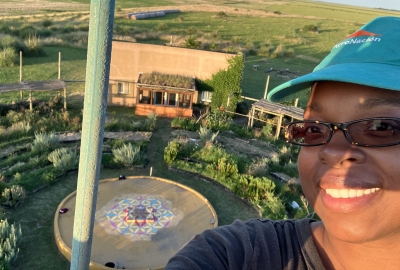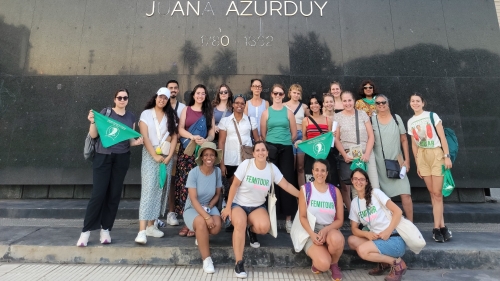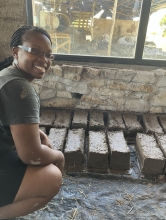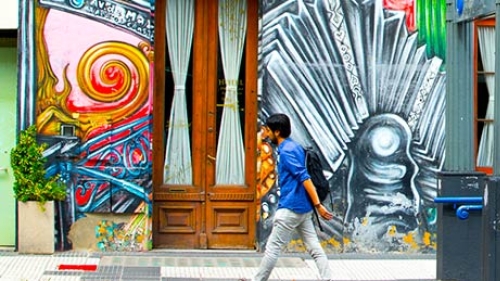
Jillian Barker Langford participated in the first cohort (January 2024) of the study abroad program: Artistic Activism, Social Justice, and Radical Education in a Third Space in Buenos Aires, Argentina. Read more about her travel journey and this immersive experience into the art, history, and culture of Buenos Aires.
Favorite Moments From the Experience:
- Favorite place - any marketplace selling art, jewelry, clothes, hats, bags, etc. These were great for buying souvenirs & small food items (think Argentinian Olive Oil or matcha). I love to pick up a scarf, skirt, or other textile from any place I visit to commemorate the occasion.
- Favorite site visit - our weekend in Quinta Esencia was such a lovely time! We had really warm and wonderful group facilitators who intentionally took their time helping us acclimate to the space. Being a bonafide city girl, this was the closest I've felt to nature in a long time, and it was a genuinely good experience. I felt like I took some of my best photography while we were here!
- Favorite tour (we took several) - the Femitour! It was so interesting to learn the feminist history of Argentina. We toured a neighborhood where the streets were named after only women. This was one of the few times that race, class, and ethnicity came up in really salient ways. We got to see how feminism is making a resurgence in Argentina alongside a glimmer of what the Afro-Argentinian experience might be like.
What is Something I Want to Remember About Buenos Aires?

Group photo of Jillian and her classmates on the "Femitour" where they learned about the feminist history of Argentina.
Buenos Aires, Argentina is an interesting place. Replete with callbacks in the architecture to its colonial past (French, Italian, and Spanish influences), to walk its streets at times feels like one has gone back in time to early 19th century France - a timeless romantic aesthetic that I did not expect in being a first-time visitor to South America while having visited France a dozen or so years ago. Taking a drive down any street and one will see store signs with Italian names above them and Italian restaurants boasting pasta and seafood dishes, while the locals seemingly exhibit no haste in their comings and goings. The social atmosphere is rather leisurely, a feeling which contrasts its historical underpinnings of civil unrest, economic collapse, deadly military dictatorships and human rights violations. Present day, feminism is making a resurgence alongside those intent on never forgetting “los desaparecidos” (the disappeared) via meaning-making through memorial sites spotlighting collective memory.
Our time in Buenos Aires, Argentina, had a spritely opener with the Femitour, a street tour in the Puerto Madero neighborhood (once abandoned and now affluent & sprawling). This tour brought explicit attention to select Argentinian women who made an impact on its culture, history, and future. One awesome highlight of this tour is that all the streets are named after women - an uncommon feature of most cities/places. Our tour guides did not shy away from questions asked regarding BA’s (and Argentina at large) relationship/perspective on race and women of color including indigenous women. They admitted that only two women who we would now consider ‘underrepresented,” had a street named after them–one indigenous, the other one Afro-Argentinian. I thought this was a great way to set the tone of our course and time in BA, by highlighting that which usually goes unnoticed or even erased–the marginalized.
Additionally, when they were asked how they identify themselves, among three women guides all of similar complexions, one claimed Italian heritage (grandparents immigrated from Italy) and therefore her parents exhibited clear Italian influences in her upbringing and home culture; however, she did not personally identify as being Italian-Argentinian, just Argentinian. The other two claimed they were solely Argentinian with no discernable outside cultural influences. I found this interesting being a slave-descended Black American woman from the United States whose ancestors participated in the Great Migration of the American South, where race and the meaning-making born of it is very much part of our national and cultural heritage. To not identify as a race and with a race would change my entire approach to identity and the meaning of self. A perspective that I admit can be burdensome at times; I have wondered before how it would feel to exist in a world that did not revolve around race, racism, and the poison it has expelled into our institutions and systems since our country’s inception.
What Experience From the Trip Was Most Impactful?

Jillian kneels with the handmade bricks that will go on to be the walls for the school building/community center at Quinta Esencia.
Quinta Esencia (QE), which means the fifth sense, is first and foremost a community established on the premises of living in harmony with the natural world utilizing public education to teach and learn from others how to maintain a genuinely sustainable lifestyle. They “dream of a Sustainable Argentina” where all aspects of existence (environmental, social, economic, cultural and spiritual) are dedicated “to the care of life.” Its primary level is composed of individuals–a chosen family of sorts–who share a worldview of ecological sustainability in its truest form. They are in charge of the care, maintenance, sustainability and growth of the organization, its land and structures, its curriculum, and community building. This community of individuals is both physically embedded in and surrounded by a local community, with which there is a mutual exchange of teaching and learning.
The school at QE is all around! It is not confined to the four walls, floor, and ceiling of a singular building. Now, they are in the process of building a more “formal” space where workshops, classes, cooking, and community gatherings may take place, but alas, those events will continue to take place throughout the grounds, as well. While the building is undergoing construction, an extensive and deliberately communal building process for which there is no rush and no hard deadline to ensure the holistic involvement of every individual and group that visits QE has a physical hand and foot in the building process.
Part of this public education campaign is the practice of embodiment and physically connecting with nature. For example, while contributing to their construction process, we were shown how to mix clay with water to make a natural binding agent for -the sand and hay, all three of which combined, molded, and air-dried, resulting in bricks that will be made into walls for this school building/community center. Every group participates in this process that requires you to get into a vat of clay and water mixed by foot, and so on and so forth with each stage of the process. Along the way, QE leaders explain the history and vision of this aspect of the project and emphasize the contribution each visiting group has made to its cumulative work and overall history. This is essentially the blueprint for how their mark is made on the world - public education, one person, one group at a time. In the time it takes to teach the steps of the process, they are also sharing in the labor, humor, and atmosphere of the group–building community, creating change, leaving a lasting impact.
I feel like as an adult, we can get set in our routines, habits, and personal practices, and anything outside of our comfort zone simply requires too much energy or motivation to experience. Being able to experience QE the way we did was a priceless experience–one I think everyone should have at least once in their lives if they are unaware that living (not just survival) can be so rewarding, especially when it comes to paying it forward to the community.
Argentina: Artistic Activism, Social Justice, and Radical Education in a Third Space
Learn more about this study abroad experience including expected program dates, eligibility, and how to apply.
Learn More
